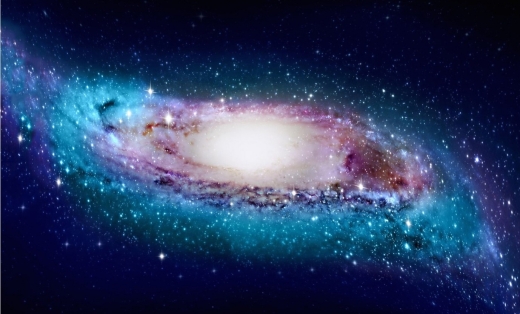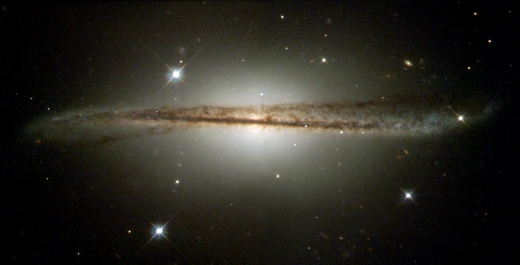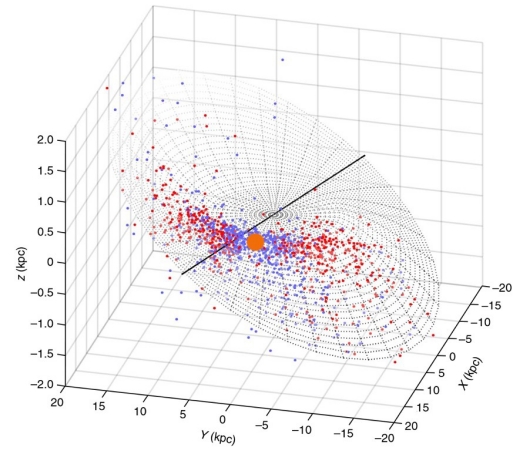Figuring out the shape of things — where to place what we see in the sky in a 3-D representation — has always been challenging. We’re looking out at a disk of stars from well within it, and it wasn’t until the 1920s and the work of Edwin Hubble that we began to see there were other such disks, not nebulae at all but galaxies in their own right, some bigger than ours. Interestingly, Immanuel Kant had speculated about this as far back as 1755.
About our own galaxy, we still have much to learn, as I am once again reminded by a paper by authors from Macquarie University (Australia) and the Chinese Academy of Sciences. The Milky Way turns out to be not as flat as many depictions would have us believe. In fact, our galaxy shows distinct signs of warping, a spiral pattern that appears to be the result of torque produced by the Milky Way’s massive inner disk of closely packed stars.
In the outer regions of the galaxy’s neutral hydrogen disk, the warp becomes readily apparent. We wind up with a shape something like the one in this artist’s impression below:

Image: A slightly exaggerated impression of the real shape of our warped and twisted Milky Way. Credit: Xiaodian Chen (National Astronomical Observatories, Chinese Academy of Sciences).
The twisted spiral pattern is hardly unique to the Milky Way. In fact, about a dozen other galaxies are known to display such patterns.

Image: The galaxy ESO 510-G13 is an edge-on warped spiral galaxy. Similar to the Milky Way it has a pronounced warp in its gaseous disc and a less pronounced warp in its disc of stars. Credit: NASA/Space Telescope Science Institute.
Demonstrating a spiral pattern from within the galaxy under study is not easy, says lead author Xiaodian Chen (Chinese Academy of Sciences, Beijing):
“It is notoriously difficult to determine distances from the Sun to parts of the Milky Way’s outer gas disc without having a clear idea of what that disc actually looks like. However, we recently published a new catalogue of well-behaved variable stars known as classical Cepheids, for which very accurate distances can be determined with an error of only three to five per cent.”
Using Cepheid variables found in data from the Wide-field Infrared Survey Explorer (WISE) mission as well as a variety of optical surveys, the researchers set about producing a three-dimensional picture of the galaxy out to its farthest regions. Cepheid variables are helpful here because they vary in brightness, and their luminosity and pulsation period are directly linked. Observing a Cepheid variable’s pulsation period allows one to know its true luminosity. The distance to the star can then be calculated by comparing known luminosity to the brightness astronomers observe (hence the nickname ‘standard candles’ to describe such stars).
What the scientists found was that the 1339 Cepheids tracked the neutral hydrogen disk of the Milky Way, with an S-like spiral pattern apparent in each as we move toward the galaxy’s outer regions. From the paper:
…we establish a robust Galactic Disk model based on 1,339 classical Cepheids. We provide strong evidence that the warp’s line of nodes is not oriented in the Galactic Centre-Sun direction. Instead, it subtends a mean angle of 17.5° ± 1° (formal) ± 3° (systematic) and exhibits a leading spiral pattern. Our Galaxy thus follows Briggs’ rule for spiral galaxies, which suggests that the origin of the warp is associated with torques forced by the massive inner disk . The stellar disk traced by Cepheids follows the gas disk in terms of their amplitudes; the stellar disk extends to at least 20 kpc… This morphology provides a crucial, updated map for studies of the kinematics and archaeology of the Galactic Disk.

Image: The units ‘kpc’ (kiloparsecs) along the image’s three axes are used by astronomers to indicate distances on galaxy-wide scales. One kiloparsec is equivalent to about 3,262 light years. Credit: Chen et al.
The paper is Chen et al., “An intuitive 3D map of the Galactic warp’s precession traced by classical Cepheids,” Nature Astronomy 04 February 2019 (abstract). Thanks to Alex Tolley for useful information on this work.



There’s been a lot of interesting work in this area recently. An important assertion is that the apparent cut-off in the stellar disc is an illusion caused by the warp and flair of the outer disc. In fact the stellar disc extends to over 25kpc radius.
Here is another interesting article on this subject:
“Disk stars in the Milky Way detected beyond 25 kpc from its center”
https://arxiv.org/abs/1804.03064
Here is another article related to this subject:
“Disk stars in the Milky Way detected beyond 25 kpc from its center”
https://arxiv.org/abs/1804.03064
“…Our analysis reveals the presence of disk stars at R>26 kpc (99.7% C.L.) and even at R>31 kpc (95.4% C.L.)….”
Where is Andromeda (direction the Milky Way’s headed) on the kpc 3D graphic?
My favorite warped galaxy: NGC 660
http://chart32.de/images/objects/galaxies/NGC660/NGC660_80.jpg
I am interested in the Briggs paper that is referenced with regard to galactic warping dynamics but it’s from 1990 and arXiv doesn’t appear to go back that far. Anyone know if it’s available online and not behind a paywall? I had thought warping was due to mergers and interactions with other, smaller galaxies.
Just in case anyone followed up on this, I found a copy. Thanks.
Good. I was looking but had come up short.
Paul, thanks for looking. In case anyone is interested here is the link I found for the 1990 Briggs paper. Although I have time to spend on this due to being housebound with the common cold my attention span is only a few minutes at a time, so I’m only partway through.
http://adsbit.harvard.edu/cgi-bin/nph-iarticle_query?1990ApJ…352…15B&classic=YES
I’ve been through the Briggs paper and I don’t see in there a study of or the conclusion “which suggests that the origin of the warp is associated with torques forced by the massive inner disk .” A couple of possible mechanism were suggested, referencing earlier work which I haven’t read.
What the paper says in the conclusions is this: “Thus, the apparent longevity of warps may serve to place constraints on the asphericity of the dark halo (Tubbs and Sanders 1979) or may point to a continuing acquisition of angular momentum from a “cosmic drizzle” (Binney 1989) created by a smooth reversal of the Hubble flow in the vicinity of massive, isolated galaxies.”
However, Briggs only included in his survey galaxies that are well isolated and have no companions, implying that it is something within the galaxy causing the warp. This doesn’t exclude warping due to external causes. For example, the Milky Way’s warp could at least in part be due to companions such as the LMC and SMC. At least I didn’t see this specifically ruled out in Chen’s paper.
You wrote: Observing a Cepheid variable’s pulsation period allows one to know its true luminosity. The distance to the star can then be calculated by comparing known luminosity to the brightness astronomers observe (hence the nickname ‘standard candles’ to describe such stars).
How reliable were the researchers’ measurements of the extinction due to dust and gas in the galactic plane? How would errors in that affect the observed degree of warp?
The paper addresses extinction at considerable length. An introductory mention is this:
“To mitigate the influence of extinction in the Galactic plane and of photometric uncertainties at infrared wavelengths, we adopted the ‘infrared multi-passband optimal distance method’
to determine accurate Cepheid distances. Contaminants, including type II Cepheids, long-period eclipsing binaries and quasi-periodic variables were removed using Gaia Data Release 2 parallaxes. Cepheids located in areas centred on the Magellanic Clouds were also excluded. Careful sample selection resulted in a tally of 2,330 classical Cepheids for further analysis.”
The complete analysis of extinction appears in the ‘methods’ section of the paper.
I wonder if this warp is more common to spiral galaxies than we think?
The authors state that the warp is due to:
Last year, we had an analysis suggesting that Sagittarius A has made multiple passes through the galactic plane leaving a signal if warped velocities. Gaia Data Hint at Galactic Encounter
I cannot help but wonder if the 2 different distributions noted are truly from different causes or from the same one.
https://arxiv.org/abs/1811.02590
When will the Milky Way and Andromeda galaxies collide?
By EarthSky in Space | February 8, 2019
The Andromeda galaxy is the nearest large spiral to our Milky Way. Astronomers have suspected for some time it will eventually collide with our Milky Way. Now – thanks to the Gaia satellite – they know more.
https://earthsky.org/space/gaia-new-insights-milky-way-andromeda-collision